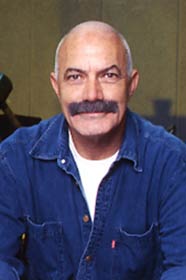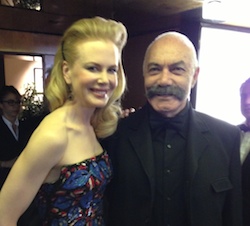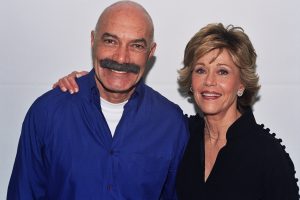“Mad Max: Fury Road” is set 45 years after the fall of the world. There is no rule of law, no power grids, no water, and no mercy. Civilization is a memory, and only to a few.
The world’s great economies have fallen into dust, the coastal cities have been erased, and in the wake of wars for water and oil, food is scarce and air is poison. What’s left of humanity roams the Wasteland in wild tribes or clings to survival at the foot of the Citadel, a fortress spun into a cave system where water is pumped from the only aquifer for miles around. By controlling the essentials, the Citadel and its allies, Gas Town and the Bullet Farm, control the Wasteland.
“When you go into a reduced, dystopian future, you’re really going back to an almost medieval past,” Miller comments. “People are just surviving. There is no honor, and very little time for empathy or compassion. This gives rise to a clear balance of hierarchy—with the powerful few literally above the many, and above the moral. And into this world comes Max, who is simply trying to escape his demons.”
Max Rockatansky was first introduced in Miller’s original 1979 film, and the character’s global resonance took even his creator by surprise. “I realized I’d unconsciously tapped into that classic mythological archetype,” he says. “In Japan, they called Max a lone Ronin Samurai. In France, they saw the film as a ‘Western on wheels’ and Max as the lone gunslinger. In Scandinavia, some said Max reminded them of a solitary Viking warrior, wandering the harsh landscape.”
Casting Tom Hardy in the role, Miller knew he’d found an actor who could bring a palpable truth to the mythic figure, noting, “It’s easy to be cautious as an actor, but there are some who are emotional warriors, and that’s Tom. He’s fearless. I was waiting for someone like Tom to come along and knew he would find the soul of Max within himself.”
Miller sensed in Hardy a quicksilver energy that recalled his first encounter with Mel Gibson when he initially cast him as Mad Max three decades ago. “It’s a charisma born out of paradox that makes him so compelling to watch,” the director posits. “Tom can be accessible, yet mysterious; tough, yet vulnerable. There’s tremendous warmth, but also an element of danger.”
Hardy was just six weeks old when the first film was released, but grew up very much aware of the Road Warrior legend. Once he wrapped his mind around the director’s vision, he understood that he wasn’t being asked to revisit the character but to reinvent it. “Mel’s Max is iconic,” Hardy relates. “But when George asked me to play this character, I entered into a collaboration with him to transmute Max for the events in this film. It’s brilliant material and a great honor to play this role.”
Still, Hardy reached out to Gibson to seek his blessing. “We had lunch, and it was good. He handed over the torch.”
Embodied by Hardy, Max Rockatansky emerges as a veteran of some desert war with a skill set that allows him to survive alone, having learned that attachment only leads to sorrow in a hostile world. “Max is somebody who just wants to go home, but there is no home,” Hardy says. “There’s nothing but silence, pain and destruction. He lives in a place where there’s no humanity, yet he still yearns for it. But relationships cost in this world.”
In the film, we find Max contemplating the dead, featureless void of the Plains of Silence, where his battered Interceptor, the last remnant of his old life, has taken him. “He’s seen a tremendous amount of trauma and horror, and everything he cares about is lost,” Hardy notes. “But even though his life, in many ways, is not worth living, there’s an argument to defy death. He’s not ready to die until he metes out a certain amount of justice for everything that has been taken from him.”
The moment is extinguished with the roar of supercharged engines as Max is swarmed by a wild pack of marauding War Boys, who ambush the wanderer, then drag him back to the Citadel—the most fortified stronghold in the Wasteland—where the car will be restored and Max will be rendered as livestock.
It’s at the Citadel that we meet Furiosa, whose rage will trigger the coming Road War. Furiosa’s journey as a female warrior in a world that enslaves women is what first pushed Miller onto the path to realizing “Mad Max: Fury Road,” and the director says Theron made her struggle very real. “Charlize is a very strong woman, not just physically but also in spirit,” he notes. “At the same time, you recognize her vulnerability. It’s not a mask. Charlize is unmistakably a woman, but this is a character who makes no concession to being female. Her life has been one of sorrow and pain, but there’s no time for reflection. She just has to go out there and be hardcore, and Charlize has the passion and skill as an actor to go there without fear.”
In Furiosa, Theron felt Miller had conjured an alpha female unlike any other she’d seen, especially in an action setting. “When George told me he wanted to create a female Road Warrior who can stand next to this very iconic character as his equal, I believed him and he didn’t let me down. The material allowed for two characters who don’t fall for each other, or even become friends, because there is no room for relationships in this place.”
That collision became even more combustible with Hardy in the mix. “There’s an elated feeling when you’re bringing that dynamic to life opposite an actor like Tom Hardy, who is playing at such an impressive level,” she shares. “You really want to set the bar with him.”
For Hardy’s part, the emotion Theron layered into the character, with minimal dialogue and near-constant action, left him awe-struck. “Charlize is a heavyweight,” he states. “There are very few actors on the planet who can deliver such tremendous strength and presence but also a tremendous amount of vulnerability.”
As an elite Imperator at the Citadel, Furiosa drives the War Rig—a mobile war machine and the most valuable vehicle in service of the Warlord of the Wasteland: Immortan Joe.
In conceiving the film’s complex and imposing villain, Miller considered the degree of skill, intellect and unquenchable hunger for power that would drive a character to not only survive the death-spiral of civilization, but to thrive. Immortan Joe finds the answer in water, Aqua Cola. It’s one of the only real currencies in the Wasteland, and he uses it to obtain the others—fuel from Gas Town and munitions from the Bullet Farm—and to subjugate the sick and starving masses who’ve migrated to the Citadel.
Perched high atop his fortress is its most protected chambers, where the Immortan runs his operation, and hoards in a sealed vault that which is most precious to him—his Five Wives. He knows his hard-fought primacy has no hope of enduring through his two surviving sons—Rictus Erectus, played by Nathan Jones, a child in the body of a humungous man; and Corpus Colossus, played by Quentin Kenihan, a mature intellect encased in a child’s body. “Neither of them is able to take over when the Immortan’s gone, so he has imprisoned healthy young girls in a climate-controlled vault, and is impregnating them to produce a healthy male heir,” Miller relates.
Casting the Warlord
The director didn’t have to look far to cast the role of the Warlord. On the first “Mad Max,” he had cast Hugh Keays-Byrne as the gleefully psychotic Toecutter. At the time, the freewheeling actor had volunteered to help pull together a cast and, if Miller would just ship the bikes, he’d lead a three-day road rally from Sydney to the Melbourne set of “Mad Max.” Much to Miller’s amazement, by the time they arrived, Keays-Byrne had transformed a loose band of actors into an authentic biker gang.
“That’s the kind of charisma I needed big time on ‘Fury Road,’” Miller says. “Hugh wears a mask in the film, so no one will mistake him for the Toecutter, and he’s got those amazing eyes and great power in his voice. He’s a lovely, big teddy bear of a guy, and brings a real playfulness to the character. Purely by the force of his personality, he added another layer to the film. He really energized our War Boys.”
The Warlord has indoctrinated the War Boys in his self-created myth that he is an immortal returned to deliver them to the warrior paradise of Valhalla, so they fling themselves into road combat with religious fervor. Their other religion is steel and V-8 engines, and as Black Fingers, they tend Immortan’s war armada in the middle ranks of the Citadel, refueling from the Blood Bank to prolong their half-lives.
“The Immortan would flay you alive for not accepting that he’s a god,” Keays-Byrne expresses. “Looking at the situation from his point of view, people are dying at a massive rate from the pollution in the environment, so he’s set up a breeding program, blood banks, milk banks, hydroponics, anything to keep the race going. He keeps his War Boys powered up on clean blood because they can’t fight for him if they die from disease. He loves his boys. And that’s what dictators do.”
“It is something of a moral dilemma,” screenwriter Brendan McCarthy suggests. “The Immortan is trying to rescue the human race from its current genetic breakdown, but he wants to do it by preserving his already ailing bloodline. He’s using brutal, homicidal methods to do so, and he invents a religion to keep his War Boys enthralled.”










